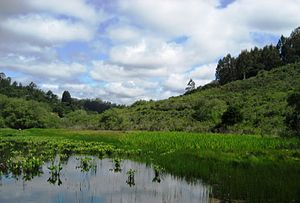
The California tiger salamander is a vulnerable amphibian native to California. It is a mole salamander. Previously considered to be a subspecies of the tiger salamander, the California tiger salamander was recently designated a separate species again. The California tiger salamander distinct population segment (DPS) in Sonoma County and the Santa Barbara County DPS are listed as federally endangered, while the Central California DPS is listed as federally threatened. The Sonoma County, south San Joaquin, and the Santa Barbara County DPS have diverged from the rest of the California tiger salamander populations for over one million years, since the Pleistocene and they may warrant status as separate species.

Don Edwards San Francisco Bay National Wildlife Refuge (DESFBNWR) is a United States National Wildlife Refuge located in the southern part of San Francisco Bay, California. Its headquarters and visitor center are in the Baylands district of Fremont, next to Coyote Hills Regional Park, in Alameda County. The visitor center is on Marshlands Rd, off Thornton Ave.

The Santa Cruz long-toed salamander is an endangered subspecies of the long-toed salamander, which is found only close to a few isolated ponds in Santa Cruz and Monterey Counties in California. It has a black body, broken yellow or orange irregular striping along its spine, and a tail fin well evolved for swimming. Like other mole salamanders, it is found near pools or slow-moving streams and has a very secretive lifestyle, making it difficult to find.
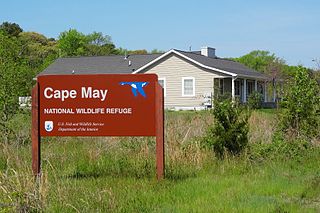
The Cape May National Wildlife Refuge is a protected area on the Cape May Peninsula in Cape May County, New Jersey. It is part of the National Wildlife Refuge System and managed by the United States Fish and Wildlife Service. Established in January 1989 with 90 acres (0.36 km2) acquired from the Nature Conservancy, it has since grown to more than 11,000 acres (45 km2) in size, and plans call for its further expansion to more than 21,200 acres (86 km2). It comprises three distinct and non-contiguous units: the Delaware Bay Division, the Great Cedar Swamp Division and the Two Mile Beach Unit. Located in the Middle Atlantic coastal forests ecoregion, the cape provides habitat for large numbers of migratory birds.
The Stewart B. McKinney National Wildlife Refuge is a 950-acre (384.5 ha) National Wildlife Refuge in ten units across the U.S. state of Connecticut. Located in the Atlantic Flyway, the refuge spans 70 miles (110 km) of Connecticut coastline and provides important resting, feeding, and nesting habitat for many species of wading birds, shorebirds, songbirds and terns, including the endangered roseate tern. Adjacent waters serve as wintering habitat for brant, scoters, American black duck, and other waterfowl. Overall, the refuge encompasses over 900 acres (364.2 ha) of barrier beach, intertidal wetland and fragile island habitats.
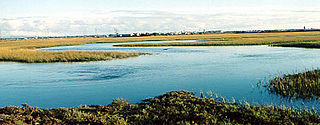
Seal Beach National Wildlife Refuge is a wildlife refuge encompassing 965 acres (3.91 km2) located in the California coastal community of Seal Beach. Although it is located in Orange County it is included as part of the San Diego National Wildlife Refuge Complex. It was established in 1972.

Elkhorn Slough is a 7-mile-long (11 km) tidal slough and estuary on Monterey Bay in Monterey County, California. It is California's second largest estuary and the United States' first estuarine sanctuary. The community of Moss Landing and the Moss Landing Power Plant are located at the mouth of the slough on the bay.

The ornate shrew is a species of mammal in the family Soricidae (shrews). It is endemic to western North America, ranging from Northern California in the United States to the Baja California peninsula in Mexico. Eight subspecies are known, including the extinct tule shrew, known only from four specimens collected in 1905, and the Suisun ornate shrew, a species of conservation concern in California. Through skull morphology research and genetic testing on Ornate shrew populations, it has been shown that there are three main genetic subdivisions: The Southern, Central and Northern. These three genetic subdivisions of Ornate shrew arose from populations of Ornate shrews getting geographically isolated from other populations.
Moro Cojo Estuary State Marine Reserve (SMR) is a marine protected area established to protect the wildlife and habitats in Moro Cojo Slough. Moro Cojo Slough is located inland from Monterey Bay on the central coast of California, directly south of the more widely known Elkhorn Slough. The area covers 0.46 square miles (1.2 km2). The SMR protects all marine life within its boundaries. Fishing and take of all living marine resources is prohibited.
The San Luis National Wildlife Refuge Complex is located in the northern San Joaquin Valley, within Merced County and Stanislaus County of California. The complex, with four federal National Wildlife Refuges, is managed by the U.S Fish & Wildlife Service.

Roanoke River National Wildlife Refuge was established in 1989 to protect and enhance wooded wetlands consisting of bottomland hardwoods and swamps with high waterfowl value along the Roanoke River. The extensive bottomland hardwood habitat of the Roanoke River National Wildlife Refuge is part of what the Nature Conservancy calls "one of the last great places."
The John H. Chafee National Wildlife Refuge is a national wildlife refuge of the United States, located along the Narrow River on the southern coast of Rhode Island.
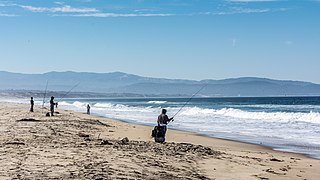
Salinas River National Wildlife Refuge is located approximately 11 miles north of Monterey, California, and 3 miles south of Castroville, California, at the point where the Salinas River empties into Monterey Bay. The 367-acre (1.49 km2) refuge encompasses several habitat types including sand dunes, pickleweed salt marsh, river lagoon, riverine habitat, and a saline pond. The refuge was established in 1974 because of its "particular value in carrying out the national migratory bird management program."
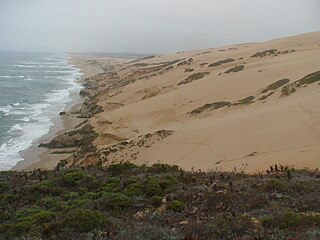
The Guadalupe-Nipomo Dunes National Wildlife Refuge is a 2,553-acre (10.33 km2) protected area located along the Central Coast of California, in southern San Luis Obispo and northern Santa Barbara Counties.
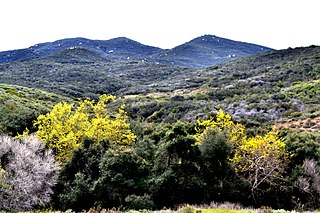
San Diego National Wildlife Refuge is a National Wildlife Refuge in California. It is part of the San Diego National Wildlife Refuge Complex. A variety of habitats from coastal sage scrub and chaparral to oak woodland and freshwater marsh describe this inland refuge in San Diego's backcountry.

Moss Landing Wildlife Area is a California State wildlife preserve on the shore of Elkhorn Slough.
The San Diego National Wildlife Refuge Complex is a series of wildlife refuges established by the United States National Wildlife Service beginning in 1972. The complex incorporates five refuges in San Diego County and Orange County in California.

Carneros Creek is a westward flowing stream and is the primary source of freshwater flowing into Elkhorn Slough. The Carneros Creek official mainstem is 9.8 miles (15.8 km) long. Its source is in the northern Gabilan Range along Highway 101/156 and thus Carneros Creek is an important wildlife corridor from that mountain range in northern San Benito County to Elkhorn Slough, the historic mouth of the Salinas River in Monterey County. Carneros Creek empties into Monterey Bay via Elkhorn Slough at Moss Landing, California.

There are 14 species of amphibians and 5 species of reptiles known to occur in Mount Rainier National Park.
